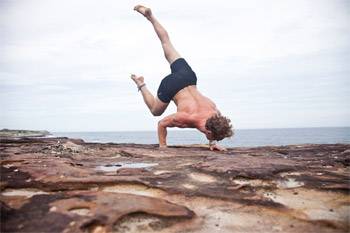4 Common Mistakes You're Probably Making While Doing Push Ups

4 Common Mistakes You're Probably Making While Doing Push Ups
Have you been doing pushups wrong forever?
Anyone who has even the slightest interest in working out, has probably tried to do a push-up at least once in their life.
They are one of the oldest and most widely known exercises on earth.
But, due to its simplicity; it is either overlooked or not performed properly.
Sports Scientist Brando Hasick, insists that 'the pushup is a fundamental element of any strength training program."
Although, there is more to push-ups than getting on all fours and moving up and down.
Hasick explains, 'Knowing the proper technique is important: It'll reduce your risk of injury, improve core strength, and for those looking to burn more calories, you can join the party too."
'All too often people overlook the benefits this exercise can provide; It can do a tremendous job of defining your abs, triceps, shoulders and torso. Every muscle in the body has to do its part for the push up to take place, " says Hasick.
Like most Calisthenic exercises, push ups teach your muscles to work in harmony with each other. To perfect the pushup, it's about establishing an efficient coordination of the muscles, but also the mind.
In simple terms, once it fires, it wires. Hasick explains that the development of a mind-muscle connection, will ensure you maintain the correct posture and technique, and that you activate the right muscles.
By forming mental habits, and repeating the same mental signals over time, the signals become easier to create and, over time more powerful in their application.
"By doing something repetitively with conscious thought, it will allow your body to begin to perform it unconsciously, known as autonomous movement," says Hasick.
Now, when it comes to push ups, there's doing push ups and then there's doing push ups well.
Hasick has put a list together, of the 4 most common mistakes people make, and how each of these can be fixed to utilise the push up to it's full potential.
Elbow Movement
The most common mistake, "The chicken wing".
By placing your arms wider than your shoulders, you put yourself at risk of developing a nasty case of shoulder impingement. Along with that you will probably find some anterior deltoid tightness, and will also provide no stimulus for the pectoralis major (pecs) whatsoever.
The Quick Fix: Tuck your elbows against your ribs, allowing your shoulders to sit backwards and down in a scapular (shoulder blade) retracted position. This opens up your pecs and anterior shoulder, allowing the force production to be made through the pecs, triceps and serratus anterior without compromising the position of the head of the humerus inside the glenohumeral joint. Simply put, you won't get a kinked shoulder and sore traps if you do it this way.
It's going to be harder, so if you need to, do them on a box or a raised apparatus to reduce the load.
You Only Concentrate On The Push
The move is called the pushup, but that doesn't mean you can ignore the decent. Hasick says, 'Avoid letting gravity do the work for you. The eccentric, or (lowering phase) when time is spent under tension (TUT) also helps to build strength."
The Quick Fix: Aim for 3 seconds of controlled eccentric loading on the way down. Ensuring you are squeezing the floor with your fingers and maintaining a hollow body position by squeezing your abs.
Your Butt Rises Or Sinks
Push-ups are a great ab exercise, but if you aren't maintaining a perfect hollow body, this is a clear indication that you're not engaging your core.
The Quick Fix: Engage your glute and abdominal muscles by squeezing the cheeks together and sucking the belly button in. This will help tense your butt and raise your lower back. Pretend like someone is about to slowly poke you in the belly button and you're trying to move your stomach out of the way to avoid the poke (sucking upwards). Keep the hands pressing firmly into the floor to maintain flared shoulder blades at the top of the back. This not only ensures full extension, but also enables the stabilising muscles within the shoulder girdle to become active and provide stability.
You're Only Doing Half A Push-Up
Far too often people don't go deep enough or high enough, but you can't improve or get stronger, by doing a half push-up. Producing a full range of motion will ensure that all of the fibres are being recruited and producing force for longer. Despite what the "gym bros" tell you, hitting full range at the top of a push up and ensuring lock out, is not a rest position.
The Quick Fix: Try to straighten your arms at the top of every push-up and be conscious that your upper arms/triceps are fully extended, with your hands pressing the floor away and flaring your shoulder blades.
MORE





